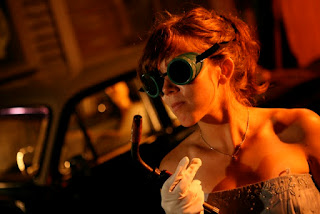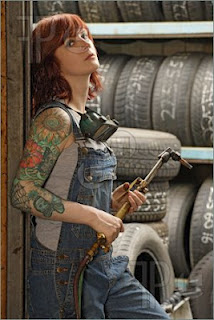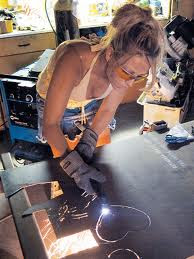Sabtu, 27 Oktober 2012
Penetration Welding
discussion concerning fastening 4130 chromoly steel on web forums and discussion boards. however apart from all the questions about pre-heating, filler metals, and conductor sort and size, Weld What concerning testing?
How does one recognize you're obtaining enough penetration in your welds. The short answer is-you cannot. you'll ne'er be completely positive you succeed the proper quantity on some weld penetration welds while not damaging the slicing and dicing and metallographic testing. however the nice news is that you simply is pretty darn positive.
By running the take a look at welds victimisation a similar actual material thickness and joint style, so by following the procedures that letter, you'll be pretty darn positive that you simply area unit sensible welds.
The following is the basic procedure to test the welds on the chromoly steel 4130:
- Determine the different weld configurations with which you need to test
- Prepare a weld joint with the exact same way as you would for production welds.
- Weld joint test and write down all the settings such as heat if used, the electrical current, electrode type and size, filler metal type and size etc.
- After the test welds and cool completely, specify multiple locations to examine the cross sections
- Part of the test welds using a slitting wheel.
- Poland weld test section ranging from 180 grit silicon carbide coarse, then 240 320, and finally 400 grit paper.
- Swap with acid and muriatic Q-tip as used in the pool (to follow all the recommendations listed on the MSDS for the safety of acid)
- Quickly rinse with baking soda and water solution to neutralize
- Check the welds using a 10x power
If the penetration is suitable, you currently have a fastening procedure for fastening 4130 chromoly is well-tried. If this procedure is followed and {also the} welds were also examined visually, you'll be pretty darn positive you've got adequate penetration and weld quality.
Senin, 15 Oktober 2012
Laser Configuration
Laser Head
At the heart of the system is U.S. Laser's unique laser head. The laser head is based on a single lamp, single ellipse, close-coupled design, optimized for maximum pumping efficiency. The design produces up to 700 watts with a small diameter (6.3 mm) rod. The single lamp reduces consumable costs, while the high efficiency reduces the energy and cooling requirements as well.
The laser head design allows for easy cascading of heads, in a series periodic resonator. Single and two-head systems are standard, and four-head systems are available.
An important feature of the design is that it is tunable: the output power can be smoothly varied from <20% to 100% of rated power without any anomalies in the beam characteristics.
U.S. Laser can also provide high brightness variants of the basic lasers, where the maximum power has been slightly reduced to significantly improve the beam quality. This is especially useful in laser cutting.
Power Supply -
Cooling Console
The electronics and cooling system, in standard systems, are housed in a caster-mounted console. The closed loop cooling system features a proportioning valve controller to maintain constant head temperature, and a high efficiency heat exchanger for connection to external cooling water/chiller.
The electronics include a high efficiency switching power supply, and a control unit with status monitoring and protection. All of these lasers may be computer controlled via digital and analog inputs. Optional IEEE 488/RS232/RS422 computer interfaces are available.
Optical Enclosure
The laser heads, in standard systems, are contained in an enclosure consisting of a tooling plate base and a hinged, interlocked cover. An optional air filtration system provides a clean, positive pressure, environment for the optics, to protect against environmental dust.
Laser Beam Delivery
U.S. Laser's High Power CW Lasers are available with both conventional and fiber optic beam delivery systems. Particular attention was paid to power handling and transmission capabilitiy to maximize power on target, and minimize optical element heating. All lens elements are fused silica, and are sized based on the full beam diameter or fiber numerical aperture.All surfaces are high damage resistant antireflection coated to provide minimum power loss.
Integrated Cabinet Systems
Multiple headed systems are also available with an integrated cabinet. These systems fully enclose the laser head and optics, power supplies and cooler in a common environmentally sealed enclosure. The laser head and optics are mounted on a granite base to insure maximum stability, and the optics are water cooled. The interior of the cabinet is temperature stabilized for use in harsh factory environments. The laser and optics are easily accessible for service and alignment from the hinged cover assembly, while removable panels provide access to the rest of the system. Normally the system is controlled and monitored via an external control computer which is supplied by the customer. An optional touch screen control box is also available.
Work Area Enclosure
U.S. Laser offers a variety of standard and custom work area enclosures to complement the high power lasers. CDRH Class I and Class IV enclosures are available. The laser systems can also be easily integrated into existing CNC or robotic machines. U.S. Laser manufactures high power CW Nd YAG laser systems, equipment and machines for laser welding, laser cutting, cladding and heat treating applications
Standard laser enclosure shown with optional
At the heart of the system is U.S. Laser's unique laser head. The laser head is based on a single lamp, single ellipse, close-coupled design, optimized for maximum pumping efficiency. The design produces up to 700 watts with a small diameter (6.3 mm) rod. The single lamp reduces consumable costs, while the high efficiency reduces the energy and cooling requirements as well.
The laser head design allows for easy cascading of heads, in a series periodic resonator. Single and two-head systems are standard, and four-head systems are available.
An important feature of the design is that it is tunable: the output power can be smoothly varied from <20% to 100% of rated power without any anomalies in the beam characteristics.
U.S. Laser can also provide high brightness variants of the basic lasers, where the maximum power has been slightly reduced to significantly improve the beam quality. This is especially useful in laser cutting.
Power Supply -
Cooling Console
The electronics and cooling system, in standard systems, are housed in a caster-mounted console. The closed loop cooling system features a proportioning valve controller to maintain constant head temperature, and a high efficiency heat exchanger for connection to external cooling water/chiller.
The electronics include a high efficiency switching power supply, and a control unit with status monitoring and protection. All of these lasers may be computer controlled via digital and analog inputs. Optional IEEE 488/RS232/RS422 computer interfaces are available.
Optical Enclosure
The laser heads, in standard systems, are contained in an enclosure consisting of a tooling plate base and a hinged, interlocked cover. An optional air filtration system provides a clean, positive pressure, environment for the optics, to protect against environmental dust.
Laser Beam Delivery
U.S. Laser's High Power CW Lasers are available with both conventional and fiber optic beam delivery systems. Particular attention was paid to power handling and transmission capabilitiy to maximize power on target, and minimize optical element heating. All lens elements are fused silica, and are sized based on the full beam diameter or fiber numerical aperture.All surfaces are high damage resistant antireflection coated to provide minimum power loss.
Integrated Cabinet Systems
Multiple headed systems are also available with an integrated cabinet. These systems fully enclose the laser head and optics, power supplies and cooler in a common environmentally sealed enclosure. The laser head and optics are mounted on a granite base to insure maximum stability, and the optics are water cooled. The interior of the cabinet is temperature stabilized for use in harsh factory environments. The laser and optics are easily accessible for service and alignment from the hinged cover assembly, while removable panels provide access to the rest of the system. Normally the system is controlled and monitored via an external control computer which is supplied by the customer. An optional touch screen control box is also available.
Work Area Enclosure
U.S. Laser offers a variety of standard and custom work area enclosures to complement the high power lasers. CDRH Class I and Class IV enclosures are available. The laser systems can also be easily integrated into existing CNC or robotic machines. U.S. Laser manufactures high power CW Nd YAG laser systems, equipment and machines for laser welding, laser cutting, cladding and heat treating applications
Standard laser enclosure shown with optional
Laser Welding
Laser welding of metals has significant advantages over traditional welding methods such as arc, TIG, and plasma welding processes. When weighing these advantages, consideration must be given to factors such as material composition, overall part size and configuration, manufacturing environment, weld quality & precision, processing time requirements, and processing cost requirements. Solid state lasers (such as Nd:YAG) are most often used for low to moderate power applications.
(Tech Note: U.S. Laser Corp 'Welding Article')
US Laser offers an assortment of both traditional Pulsed and Continuous-Wave (CW) lasers tailored for a variety of applications. Typically, Pulsed lasers are employed for Lap (penetration) welding requirements, whereas CW Lasers are used when Seam (Butt) welding is required. There are a few requirements in which a Q-switched laser may be applicable. However, review of individual customer requirement is recommended to ensure the proper laser is selected for the intended application.
In its simplest form, US Laser can provide a stand alone laser system for OEM applications. In this configuration, the laser head and associated optics are mounted on an optical rail, which is connected to a separate power supply / cooling cabinet by means of electrical cables and cooling lines. A beam delivery system (viewing and focusing module) can be incorporated as a means of directing the laser output to the work-piece. Fiber-optic beam delivery, conventional fixed beam delivery, and Galvanometer based (scanning) beam delivery systems are available depending upon the given application.
Lamp-Pumped Lasers
US Laser lamp-pumped Nd:YAG lasers employ the use of high-efficiency, long-life krypton arc-lamps to excite a solid-state Nd:YAG laser rod located within the laser cavity. The configuration of the cavity is optimized to provide high wall-plug efficiency and stable operation. Both fundamental TEM00 and multimode output modes are available. US Laser offers lamp-pumped lasers in single and multi-head configurations, with output powers ranging from several watts to 2400 watts average CW output power (link to US Laser CW systems) , up to 200 Watts average AO Q-switched output power, (link to US Laser QS systems) and up to 400 Watts average Pulsed output power. (link to US Laser Pulsed systems)
Diode-Pumped Lasers
Unlike their lamp pumped counterparts, Diode Pumped Lasers use high efficiency, long life solid state diodes as their pump source. Because of the excellent beam quality, US Laser Diode-Pumped Lasers can generally be focused to smaller spot sizes, and may be suitable for various low power welding applications. US Laser offers CW & AO Q-switched lasers in TEM 00 and multimode operation with output powers from several to 100 Watts, though higher laser output configurations are available as required on a custom basis. (link to US Laser Diode-Pumped systems)
Custom, Turnkey Laser Systems
US Laser offers custom, automated turnkey laser systems for laser welding applications. The 4000 Series Industrial Laser Systems are designed to perform demanding, precision laser processing tasks in a production environment. The Nd YAG Laser System combines accuracy and precision with stability and ruggedness for applications such as welding. (link to US Laser Machining systems) In addition, we offer several integrated cabinet laser systems which are designed for high output CW laser operation using fiber-optic beam delivery, and interfaced to a customer supplied PLC. link to US 408-2 and 408-4 CW systems)
Langganan:
Postingan (Atom)
.jpg)

